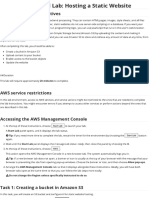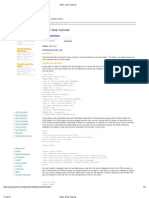0 ratings0% found this document useful (0 votes)
3 viewsAWS Assignment 5
AWS Assignment 5
Uploaded by
sobiakupeyCopyright:
© All Rights Reserved
Available Formats
Download as TXT, PDF, TXT or read online from Scribd
AWS Assignment 5
AWS Assignment 5
Uploaded by
sobiakupey0 ratings0% found this document useful (0 votes)
3 views2 pagesCopyright
© © All Rights Reserved
Available Formats
TXT, PDF, TXT or read online from Scribd
Share this document
Did you find this document useful?
Is this content inappropriate?
Copyright:
© All Rights Reserved
Available Formats
Download as TXT, PDF, TXT or read online from Scribd
Download as txt, pdf, or txt
0 ratings0% found this document useful (0 votes)
3 views2 pagesAWS Assignment 5
AWS Assignment 5
Uploaded by
sobiakupeyCopyright:
© All Rights Reserved
Available Formats
Download as TXT, PDF, TXT or read online from Scribd
Download as txt, pdf, or txt
You are on page 1of 2
Q.
Project 1:Host the static website in s3 and enable cloud distribution globally
To host a static website in Amazon S3 and enable global distribution using AWS
CloudFront, follow these steps:
Step 1: Create an S3 Bucket
Login to AWS Management Console.
Navigate to S3:
Go to the S3 service from the AWS Management Console.
Create a New Bucket:
Click on "Create bucket".
Enter a unique bucket name (e.g., my-static-website-bucket).
Select the AWS region where you want the bucket to be created.
Keep other settings as default unless you have specific requirements.
Click "Create bucket".
Step 2: Configure the Bucket for Static Website Hosting
Enable Static Website Hosting:
Select your bucket.
Go to the "Properties" tab.
Scroll down to the "Static website hosting" section.
Click "Edit".
Select "Enable" and provide the index document (e.g., index.html). You can also
specify an error document (e.g., error.html).
Save changes.
Upload Your Website Files:
Go to the "Objects" tab.
Click on "Upload" and add your website files (e.g., HTML, CSS, JavaScript, images).
Click "Upload" to transfer the files to S3.
Step 3: Set Permissions for the Bucket
Make the Bucket Public:
Go to the "Permissions" tab of your bucket.
Scroll to the "Bucket policy" section and click "Edit".
Add a bucket policy to allow public read access. Example policy:
json
Copy code
{
"Version": "2012-10-17",
"Statement": [
{
"Effect": "Allow",
"Principal": "*",
"Action": "s3:GetObject",
"Resource": "arn:aws:s3:::my-static-website-bucket/*"
}
]
}
Replace my-static-website-bucket with your bucket name.
Save the changes.
Step 4: Create a CloudFront Distribution
Navigate to CloudFront:
Go to the CloudFront service from the AWS Management Console.
Create a Distribution:
Click on "Create Distribution".
Choose "Web" as the delivery method.
Configure Distribution Settings:
Origin Domain Name: Select your S3 bucket from the list.
Viewer Protocol Policy: Choose Redirect HTTP to HTTPS for better security.
Cache Policy: Use the default settings or customize as needed.
Default Root Object: Enter index.html if necessary.
Origin Access: You can create an Origin Access Control (OAC) for additional
security to restrict access to the S3 bucket through CloudFront only.
Click "Create Distribution".
Step 5: Update DNS Settings (Optional)
Configure DNS:
If you have a custom domain, you can use Route 53 or another DNS service to point
your domain to the CloudFront distribution.
Create an A or CNAME record in your DNS settings to map your domain to the
CloudFront distribution domain name.
Step 6: Test Your Website
Access Your Website:
Once CloudFront finishes deploying (it may take some time), access your website
using the CloudFront distribution domain name.
Ensure all the content is loading correctly.
You might also like
- Lab Assignment 2-CSET 463Document20 pagesLab Assignment 2-CSET 4632412arjitchauhanNo ratings yet
- Architecting A Website Using The Serverless TechnologyDocument21 pagesArchitecting A Website Using The Serverless Technologydheeraj patilNo ratings yet
- CDM and AWS Cloud Lab Manual - Simulator - 20200529Document63 pagesCDM and AWS Cloud Lab Manual - Simulator - 20200529MirkoNo ratings yet
- Angular1 Yii2Document32 pagesAngular1 Yii2Viqi FirdausNo ratings yet
- Deploying A Static Site Using AWS S3 and CloudFrontDocument1 pageDeploying A Static Site Using AWS S3 and CloudFrontgoktasorhanNo ratings yet
- A2 CC (Assi4)Document9 pagesA2 CC (Assi4)ATHARVA PARDESHINo ratings yet
- ccpractical 9Document25 pagesccpractical 9socialmedi324No ratings yet
- Assignment No8Document2 pagesAssignment No8tiku024iiiNo ratings yet
- Hosting a static website on AWS S3Document5 pagesHosting a static website on AWS S3mypolmadhukNo ratings yet
- ICT507 Week 9 Lab 4 - 6 MarksDocument3 pagesICT507 Week 9 Lab 4 - 6 MarksArsalan ChaudhryNo ratings yet
- Configuring A Static Website On Amazon S3Document8 pagesConfiguring A Static Website On Amazon S3TECHIE HORIZONNo ratings yet
- Static Website AWS S3Document24 pagesStatic Website AWS S3jockerrockyrameshNo ratings yet
- caDocument3 pagescasunny950775No ratings yet
- Tutorial - Configuring A Static Website On Amazon S3Document9 pagesTutorial - Configuring A Static Website On Amazon S3Vijay JhaNo ratings yet
- Mini Project 2 - WebsiteDocument2 pagesMini Project 2 - WebsiteDINESH GAWANDENo ratings yet
- Ccs Answers LabDocument7 pagesCcs Answers Labmuchasandeepreddy176No ratings yet
- 20BCS4239 Micro Services Worksheet 1-1Document7 pages20BCS4239 Micro Services Worksheet 1-1amanshahwaz023No ratings yet
- Cloud Architecting Lab ManualDocument101 pagesCloud Architecting Lab ManualJsushNo ratings yet
- Cloud Computing Lab TanushriDocument19 pagesCloud Computing Lab Tanushripeacock156mstNo ratings yet
- Project Report: Hosting A Website On Amazon S3: Aws For Cloud Computing - Bece355LDocument4 pagesProject Report: Hosting A Website On Amazon S3: Aws For Cloud Computing - Bece355LshivkanyaNo ratings yet
- Exercise 2 - Building A Log-Analytics Solution With Amazon KinesisDocument12 pagesExercise 2 - Building A Log-Analytics Solution With Amazon KinesisFelipe Alejandro Morales MendivelsoNo ratings yet
- Amazon CloudFront A Comprehensive GuideDocument22 pagesAmazon CloudFront A Comprehensive GuidesureshNo ratings yet
- AWS S3 Configuration StepsDocument5 pagesAWS S3 Configuration Stepsdamien.instasuiteNo ratings yet
- AWS TutorialDocument49 pagesAWS TutorialsnikaNo ratings yet
- CC Assign5Document5 pagesCC Assign5113SOURYADIPTA DASNo ratings yet
- Cloud DocumentDocument18 pagesCloud DocumentSumit SahaNo ratings yet
- Using EC2 Roles and Instance Profiles in AWSDocument21 pagesUsing EC2 Roles and Instance Profiles in AWSSrinivasanNo ratings yet
- Module 10 - Challenge Lab_ Automating Infrastructure DeploymentDocument19 pagesModule 10 - Challenge Lab_ Automating Infrastructure DeploymentMarcus MwalukoNo ratings yet
- step-by-step instructions for migrating your Oracle database to Amazon RDS for PostgreSQL using DMS Schema ConversionDocument17 pagesstep-by-step instructions for migrating your Oracle database to Amazon RDS for PostgreSQL using DMS Schema Conversionromdhani.amazonNo ratings yet
- TASK 5 - Static Website Hosting Using AWS S3 ServiceDocument5 pagesTASK 5 - Static Website Hosting Using AWS S3 ServiceMAHAMMADGAUS SHAIKHNo ratings yet
- S3 Students' ManualDocument7 pagesS3 Students' Manualkingkyrie888No ratings yet
- AWS Foundation Course - Exercises: Instructions To Strictly FollowDocument4 pagesAWS Foundation Course - Exercises: Instructions To Strictly FollowPrabhakarNo ratings yet
- Module 3 - Guided Lab - Hosting A Static WebsiteDocument4 pagesModule 3 - Guided Lab - Hosting A Static WebsiteMarcus MwalukoNo ratings yet
- AWS Solution Project - 1Document4 pagesAWS Solution Project - 1AndyNo ratings yet
- AWS Static WebsiteDocument40 pagesAWS Static Websiteramalingam_dec100% (1)
- Storage (S3, Cloudfront)Document21 pagesStorage (S3, Cloudfront)I'm RangaNo ratings yet
- Using EC2 Roles and Instance Profiles in AWSDocument7 pagesUsing EC2 Roles and Instance Profiles in AWSHimanshu PatelNo ratings yet
- Build A Static Website With Simple Storage Service: ReadmeDocument8 pagesBuild A Static Website With Simple Storage Service: ReadmeMispa CahyaNo ratings yet
- 20BCS4241 Ms 1.1Document10 pages20BCS4241 Ms 1.1Zinda JattNo ratings yet
- Inhouse ReportDocument19 pagesInhouse Reportmohitverma9957414021No ratings yet
- Review: Authentication and Synchronization of Javascript Apps With Aws Cognito V1.03Document46 pagesReview: Authentication and Synchronization of Javascript Apps With Aws Cognito V1.03duc nguyenNo ratings yet
- saa-c03_0Document11 pagessaa-c03_0Don GladiatorNo ratings yet
- QDocument4 pagesQMaaz SayyedNo ratings yet
- CC Assign4.1Document3 pagesCC Assign4.1113SOURYADIPTA DASNo ratings yet
- Setting Up An S3 Static Website Using AWS CLI: DescriptionDocument3 pagesSetting Up An S3 Static Website Using AWS CLI: Descriptiondeniz bayraktarNo ratings yet
- Getting Started With Amazon S3: March 2017Document14 pagesGetting Started With Amazon S3: March 2017Oscar AldanaNo ratings yet
- Snowflake Continuous Data LoadingDocument13 pagesSnowflake Continuous Data Loadingsomu kNo ratings yet
- 01 Deploying Static Website With S3 BucketsDocument14 pages01 Deploying Static Website With S3 Bucketskkeyn688No ratings yet
- CCD Practical_ExamsDocument9 pagesCCD Practical_ExamsAariz FakihNo ratings yet
- Module 6 S3 Bucket CreationDocument6 pagesModule 6 S3 Bucket CreationKrrishna ChauhanNo ratings yet
- Cloud PracticalsDocument30 pagesCloud Practicalssivaashokkumar412No ratings yet
- A 03Document10 pagesA 03akashkeshni29No ratings yet
- Cloud Computing Architecture Lab 1Document12 pagesCloud Computing Architecture Lab 1David Mauricio ContrerasNo ratings yet
- Using Amazon Web Services: A Beginners Guide For Mysql UsersDocument63 pagesUsing Amazon Web Services: A Beginners Guide For Mysql Usersvkmsivaprasad4764No ratings yet
- AWS Certified Security - Specialty - Sample QuestionsDocument6 pagesAWS Certified Security - Specialty - Sample QuestionsSuresh GovindachettyNo ratings yet
- Odoo SaaSDocument9 pagesOdoo SaaSPum DissaiNo ratings yet
- AG4 Constructing+a+polyglot+data+solution Ed2Document82 pagesAG4 Constructing+a+polyglot+data+solution Ed2saphana9800No ratings yet
- Use The Azure Portal To Upload A File To Azure StorageDocument2 pagesUse The Azure Portal To Upload A File To Azure Storagejeppoo1No ratings yet
- "Hosting A Static Gym Website Using AWS S3 Service": A Project Report ONDocument15 pages"Hosting A Static Gym Website Using AWS S3 Service": A Project Report ONsiddhesh ghosalkarNo ratings yet
- AWS - Capstone ProjectDocument12 pagesAWS - Capstone ProjectAniruddha DasguptaNo ratings yet
- AWS for System Administrators: Build, automate, and manage your infrastructure on the most popular cloud platform – AWSFrom EverandAWS for System Administrators: Build, automate, and manage your infrastructure on the most popular cloud platform – AWSNo ratings yet
- Holistic Seo: Yoast Seo For Wordpress Training - Lesson 1.1Document16 pagesHolistic Seo: Yoast Seo For Wordpress Training - Lesson 1.1Mohit RuhalNo ratings yet
- Web VAPT Syllabus PDFDocument29 pagesWeb VAPT Syllabus PDFAjayPradeep BR0% (1)
- AJAX Chat TutorialDocument6 pagesAJAX Chat TutorialDeded Ramad KamdaNo ratings yet
- HTML Multiple Choice QuestionsDocument49 pagesHTML Multiple Choice QuestionsVinita Kumari100% (1)
- Group6 1Document7 pagesGroup6 1Ashish SoniNo ratings yet
- Movers and PackersDocument8 pagesMovers and PackersMover PackersNo ratings yet
- CpamarketingDocument89 pagesCpamarketingJesus PerezNo ratings yet
- Web EngineeringDocument7 pagesWeb EngineeringAbigail LlanosNo ratings yet
- Dokumen UprakDocument13 pagesDokumen UprakCaruban NagariNo ratings yet
- SANGFOR - NGAF - V8.0.5 - WAF Configuration GuideDocument25 pagesSANGFOR - NGAF - V8.0.5 - WAF Configuration Guidet.wisnu pamungkasNo ratings yet
- Chapter 2 Introduction To HTMLDocument84 pagesChapter 2 Introduction To HTMLNishigandha PatilNo ratings yet
- Shubh 0037Document26 pagesShubh 0037Abcd AbcdNo ratings yet
- Easy PrivacyDocument188 pagesEasy PrivacyAnonymous 7pc0KBiC9YNo ratings yet
- Problem Statement: Travel Website 2021-22Document8 pagesProblem Statement: Travel Website 2021-22Chandrashekar AcharyaNo ratings yet
- 01.01.1 The Modern Flexbox, Grid, Sass & Animations Developer Course ResourcesDocument3 pages01.01.1 The Modern Flexbox, Grid, Sass & Animations Developer Course ResourcesAndrijaNo ratings yet
- Myanmar Book Adult eDocument45 pagesMyanmar Book Adult eThida WaiNo ratings yet
- Crafting The Digital Experience: A Journey Into Web Design and DevelopmentDocument37 pagesCrafting The Digital Experience: A Journey Into Web Design and Developmentarjun singhNo ratings yet
- Mayank Agrawal BBPDocument10 pagesMayank Agrawal BBPIshika JainNo ratings yet
- MC7202-Web Programming EssentialsDocument8 pagesMC7202-Web Programming EssentialsArun VijayNo ratings yet
- World Wide WebDocument33 pagesWorld Wide Webvejive8780No ratings yet
- AdafDocument169 pagesAdafWaikhom SanjitaNo ratings yet
- Responsive Web Design Tutorial: (Fundamental Concepts, Without Bootstrap)Document7 pagesResponsive Web Design Tutorial: (Fundamental Concepts, Without Bootstrap)mojtaba sardarabadiNo ratings yet
- Internet Explorer VS Firefox VS Google ChromeDocument23 pagesInternet Explorer VS Firefox VS Google ChromePrachi GroverNo ratings yet
- 5 Nagios Check - HTTP Plugin Examples For HTTP - HTTPSDocument11 pages5 Nagios Check - HTTP Plugin Examples For HTTP - HTTPSAndima Jeff HardyNo ratings yet
- Fullstack Web DevelopementDocument13 pagesFullstack Web Developementsushreesubhasmita2004No ratings yet
- Temp 123Document11 pagesTemp 123amahajanbe22No ratings yet
- HTML Block and Inline ElementsDocument7 pagesHTML Block and Inline ElementsVictor Agu (Vicky)No ratings yet
- Universal Description Discovery and Integration (UDDI) : A ReviewDocument34 pagesUniversal Description Discovery and Integration (UDDI) : A Reviewnivi_09No ratings yet
- Assesment 1 QuestionDocument6 pagesAssesment 1 QuestionShailen.draNo ratings yet

























































































